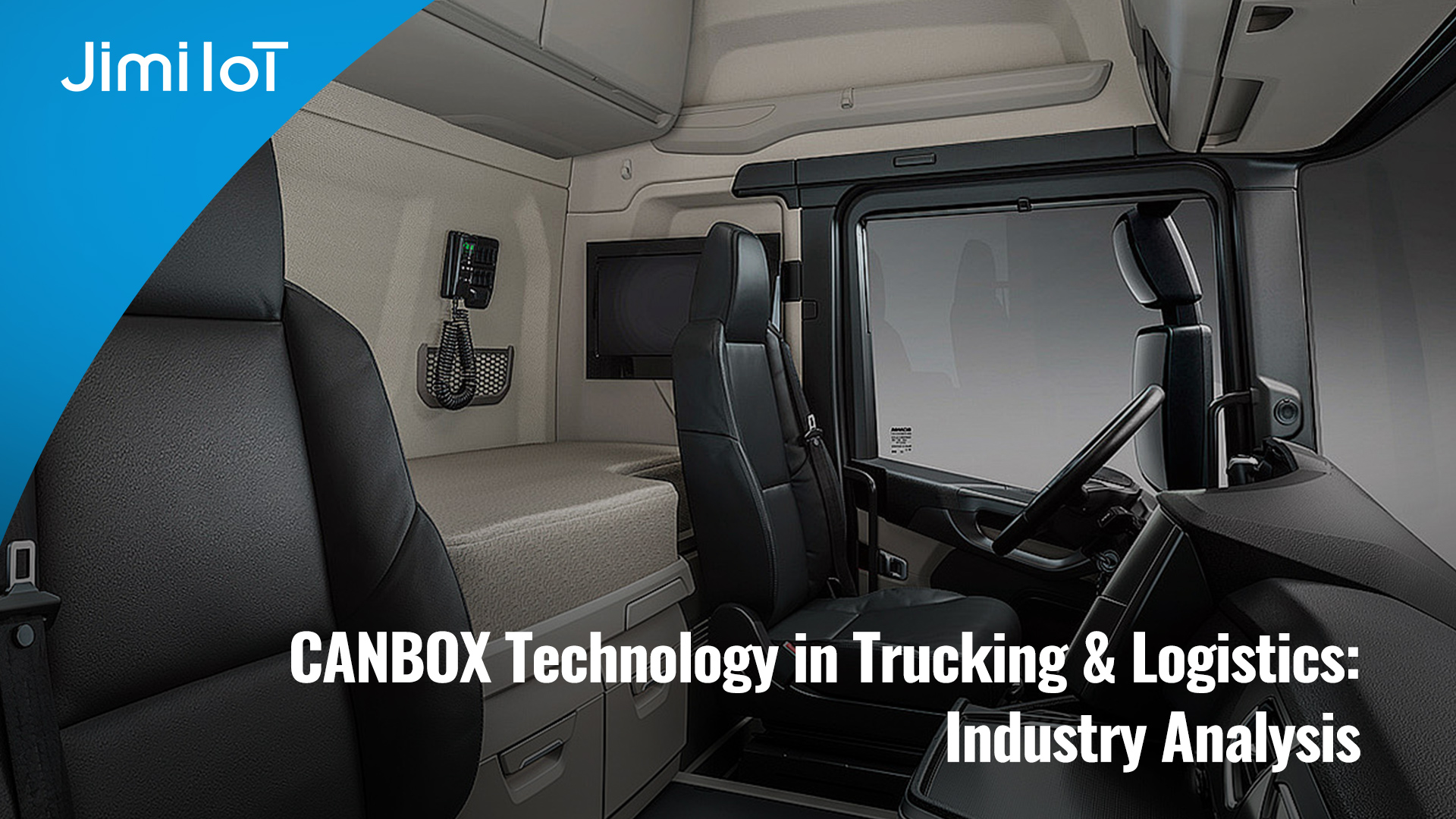The integration of vehicle network data with video recording (“CANBox” technology) is becoming a major trend in commercial fleet telematics. Industry reports highlight that camera-equipped telematics systems are growing rapidly. For instance, Berg Insight projects the installed base of video telematics devices in North America and Europe to reach 17 million units by 2029, growing at double-digit rates. Analysts explicitly call camera integration “a massive trend in the fleet telematics sector”.

Newer “CamBox” designs are emerging: these modular video-telematics terminals (e.g. Jimi IoT’s Cambox series) feature separate hidden processing units and camera heads, multi-camera support, and built-in GPS/CAN connectivity. Such devices promise discreet installation (by concealing the main unit out of sight) and real-time monitoring across multiple vehicle zones. Overall, fleet managers are placing more emphasis on complete visibility and safety: modern CamBox solutions combine live data streams (location, engine/CAN signals) with video evidence, addressing core business needs for risk management and efficiency.
CANBOX vs. Traditional DVR Systems
Traditional in-vehicle DVR systems simply record video from dashboard and cabin cameras to local storage, often without any live connectivity or vehicle data. In contrast, CANBox-style units are designed as fully integrated telematics hubs. They tap directly into the truck’s CAN bus for real-time sensor data (speed, fuel level, engine faults, etc.) while simultaneously recording multiple video streams.
Compared to DVRs, CANBox devices offer several advantages:
- Real-time data integration: CANBox terminals include built-in cellular modems (e.g. 4G LTE) and GPS, enabling live tracking and streaming. The Jimi JC451, for example, has an embedded 4G Cat.4 modem for global coverage and dual-band Wi-Fi for on-site data offload. This contrasts with DVRs that usually require manual retrieval of SD cards or physical connection to download video.
- Discreet installation: Modern designs use split-system architecture so that the bulky processor unit can be hidden under a dashboard, leaving only small camera heads visible. This minimizes driver distraction and vandalism risk. By contrast, many legacy DVRs are bulky single boxes mounted on windshields or consoles.
- AI-assisted monitoring: CANBox solutions often include on-device intelligence. They run advanced driver-assistance (ADAS) and driver-monitoring (DMS) algorithms in real time. For example, the JC451 issues lane-departure and forward-collision warnings via its ADAS logic, and detects driver fatigue or phone use via its DMS camera. Traditional DVRs typically lack these analytics, requiring fleets to manually review footage after an incident.
These innovations make CANBox terminals far more than mere cameras. They function as connected vehicle hubs, delivering synchronized video and telematics data to fleet management platforms. In short, CANBox systems provide an all-in-one solution that overcomes the limitations of standalone DVR video recorders.
Fleet Management Pain Points
Fleet operators face persistent challenges that CANBox solutions aim to solve:
- Limited visibility: Poor insight into vehicle locations, cargo status, and on-road conditions is a top concern. Analysts note “limited visibility” is one of the biggest obstacles in fleet operations. When dispatchers can’t see real-time video or sensor data, decisions (rerouting, load scheduling, etc.) suffer. Lack of visibility also leads to increased risks: companies risk theft, losses or compliance issues when assets go unmonitored.
- Delayed incident response: Without live alerting, accidents or security breaches may not be detected until hours later. For example, an overturn or theft event on a highway might go unnoticed until check-in, slowing emergency response. Modern CANBox units address this by triggering immediate alerts and clip uploads. The JC451 can be configured to recognize hard braking, speeding, or a driver pressing an SOS button – in each case it locks the relevant video segment and uploads it to the cloud. This ensures that critical footage is preserved and dispatched in real time, rather than discovered during a delayed review.
- Poor driver behavior monitoring: Unsafe driving (fatigue, distraction, aggressive maneuvers) remains a leading cause of accidents and inefficiency. Fleets often lack automated systems to identify these behaviors continuously. Studies show telematics can make a huge difference: vehicles using connected monitoring have 20–25% fewer crashes, and risky driving events drop by about 34%. In specialized sectors like fuel transport, companies report driver misbehavior (e.g. eating while driving, texting) in the majority of cases. Without AI dashcams, spotting such behaviors is labor-intensive. CANBox products with ADAS/DMS fill this gap by warning drivers in real time and logging events for coaching. One fleet camera vendor notes that AI dashcams have helped some clients eliminate forward collisions entirely in a given period.
- Maintenance inefficiencies: Reactive maintenance is costly. Fleets without live diagnostics end up scheduling service after failures. Telematics helps by turning vehicle health data into alerts. Research finds that using GPS and onboard sensors significantly improves maintenance: nearly half of fleets surveyed said telematics improved their maintenance scheduling and uptime. By tapping CAN signals, a system can monitor engine faults, fuel sensors, and run predictive servicing. For example, Trackunit highlights that real-time CAN data yields “predictive service alerts,” cutting unplanned downtime. Thus, fleets tied to old-style DVR-only setups struggle with inefficiencies that CAN-integrated systems can preempt.
In summary, fleet managers need complete visibility and speedy alerts. CANBox solutions address these pain points by delivering a unified stream of video and vehicle data, enabling immediate action on incidents, proactive driver management, and scheduled maintenance.
JC451 Multi-Channel AI CamBox
Responding to these needs, Jimi IoT has released the JC451 Multi-Channel AI CamBox, a professional video telematics terminal built for trucks and logistics fleets. This next-generation CamBox incorporates all of the benefits above: it integrates live CAN-bus data, multi-angle video, AI analytics, and secure cloud connectivity in one package. Key features include:
- Split-System Design & Connectivity: The JC451 separates its main processing unit from its camera modules, allowing installers to conceal the processor (e.g. under the dash or behind headliner) and keep the camera heads minimal. It also includes a built-in 4G LTE Cat.4 modem for cellular connectivity and dual-band Wi-Fi for local data transfer. Combined with an internal GNSS receiver, the device supports real-time tracking and live video streaming on a global scale.
- Multi-Camera Support: The system records from up to 5 camera channels simultaneously (one built-in camera plus four externals). This enables fleets to cover all critical viewpoints – e.g. road ahead, rear view, side angles, and cabin – at once. According to Jimi’s documentation, the JC451 delivers “video visibility via up to 5 channels in real time” to fleet managers.
- AI Safety Algorithms (ADAS & DMS): Onboard AI runs Advanced Driver-Assistance and Driver Monitoring. The JC451’s ADAS module issues forward-collision and lane-departure warnings to alert drivers before hazards. Its optional DMS camera watches the driver’s face for drowsiness or distraction (e.g. eyes off road or phone use) and sounds alarms when attention wanes. These real-time safety alerts are processed on-device, improving risk prevention without needing constant human monitoring.
- Extended Redundant Storage: The CamBox has two microSD card slots (for backup redundancy), each supporting up to 256 GB. This massive onboard storage is ideal for long-haul trucks that may spend days on the road. With up to 512GB total local storage, the JC451 can archive continuous multi-channel HD video for extended periods before offloading.
- Event & SOS Alerts: The unit supports event-triggered recording and alerts. It can be configured to lock and immediately upload footage when events like hard braking, speeding, impacts, or an in-cab SOS button activation occur. For example, pressing the panic (SOS) button will automatically secure the surrounding video clips and send them to the cloud. Similarly, speed or collision triggers can generate instant multimedia alerts. This ensures critical evidence is preserved and transmitted without relying on looped recording alone.
- Fleet Compatibility & Integration: Designed for commercial vehicles, the JC451 runs on a wide voltage range (9–36 V) and works with industry-standard mounts. It offers rich I/O options (RS232/TTL serial ports, digital inputs, relay outputs) so integrators can connect peripherals like fuel or temperature sensors, driver ID readers, and alarms. All recorded data and alerts integrate with Jimi IoT’s Tracksolid Pro cloud platform, giving operators a unified interface for live video, GPS tracks, and reports.
Together, these features make the JC451 a full-spectrum video telematics terminal tailored for trucking and logistics. It combines discreet hardware design with high-end connectivity and AI analytics, directly addressing fleet managers’ needs for safety, oversight, and efficiency.
JC451 vs. JC450: Next-Gen Enhancements
The JC451 builds upon the proven capabilities of Jimi’s previous JC450 series while adding significant enhancements. The older JC450 was itself a 4/5-channel LTE dashcam with ADAS/DMS and cloud upload functions. Key differences and improvements in the JC451 include:
- Split-System & Discreet Installation: The JC451’s split architecture is its most distinctive upgrade. Unlike the all-in-one JC450 box, the JC451 allows the processor to be hidden under the dashboard. This “truly hidden installation” avoids blocking the driver’s view and significantly improves tamper resistance. Jimi even advises mounting the camera behind the rearview mirror so it is “completely invisible from the driver’s perspective” – an option not available on the bulkier JC450 unit.
- Expanded I/O (Extension Interface): Both models support additional sensors, but the JC451’s new extension interface offers greater flexibility. It retains serial ports (RS232/TTL) and programmable I/Os that let customers plug in fuel meters, temperature probes, RFID drivers ID, panic buttons, etc.. These ports existed on JC450 as well, but Jimi has emphasized them as a standout feature of the JC451, enabling easier customization for diverse fleet use-cases.
- Legacy Feature Set: In all other respects (video channels, AI algorithms, connectivity), the JC451 carries over the JC450’s high-end platform. Both offer 4–5 channel HD recording with dual AI (ADAS and DMS) for safety alerts. Both include built-in LTE/Wi-Fi and cloud integration for instant data upload. Notably, Jimi points out that features like remote vehicle immobilization (anti-theft fuel cut-off) and dual-memory redundancy are also present in JC450 documentation and are preserved in the JC451.
- User Experience: The split design and refined software make the JC451 easier to deploy and use. Cable routing is simpler since the heavy unit can be tucked away. Fleet managers access all JC450/JC451 feeds on the same Tracksolid Pro portal, but the JC451’s improved interface (USB configuration, on-site Wi-Fi) streamlines setup. Overall, the JC451 delivers the full functionality fleets expect from the JC450, while adding better ergonomics and scalability.
In summary, the JC451 represents an evolution over the JC450. It maintains the JC450’s proven core (multi-camera recording, AI safety alerts, connectivity), but introduces a superior split-system form factor and greater expandability. For trucking fleets, this means a more robust and flexible video-telematics solution that addresses both operational and user-experience requirements beyond the previous generation.
Why JimiIoT
JimiIoT is a global leader in innovative IoT solutions. We provide cutting-edge hardware and software tailored to enhance efficiency and connectivity. Our range of products includes advanced GPS tracking devices, asset management solutions, smart vehicle dashcams, and telematics platforms. With a focus on technological excellence and customer satisfaction, we empower businesses to optimize operations and gain valuable insights from data-driven analytics. Trust JimiIoT to drive positive change and unlock growth opportunities in the digital age.
If you would like more details, please visit Facebook, LinkedIn, INS, and Twitter pages for further information.
 EN
EN ES
ES PT
PT TH
TH VN
VN JP
JP



